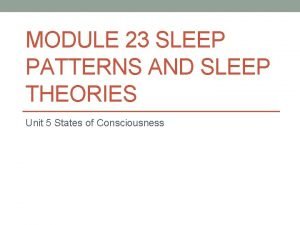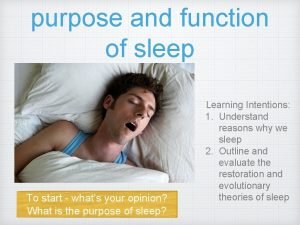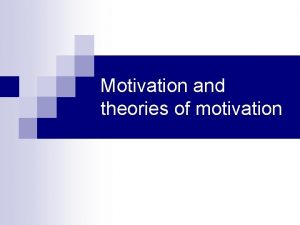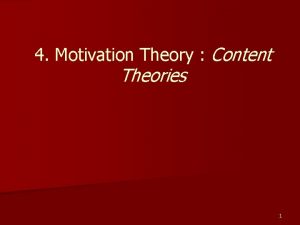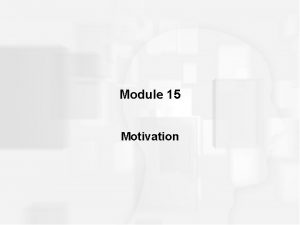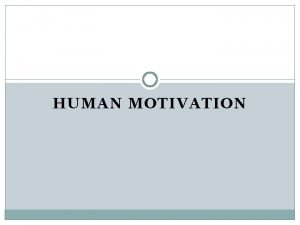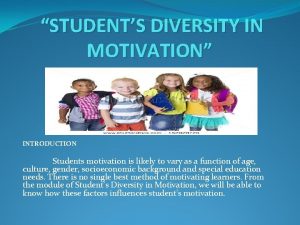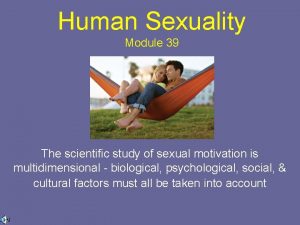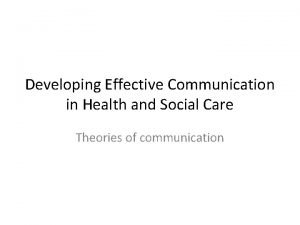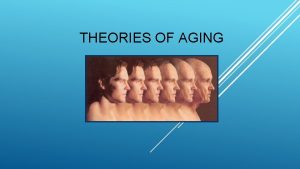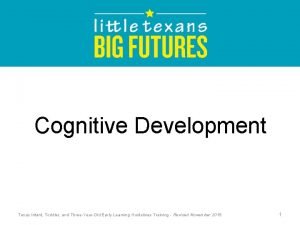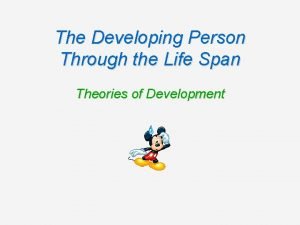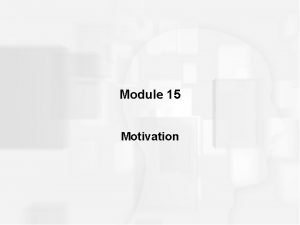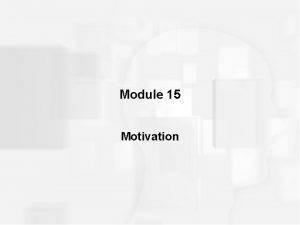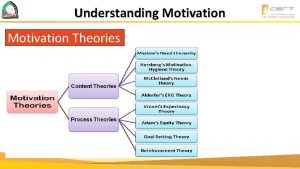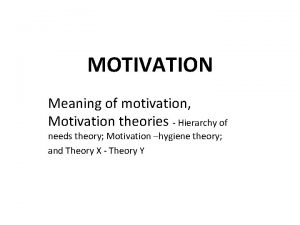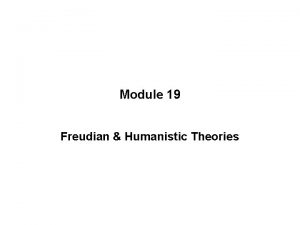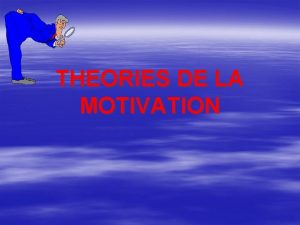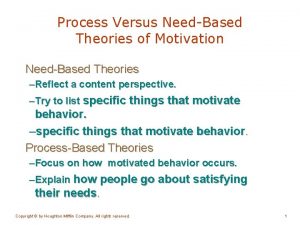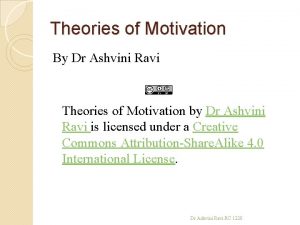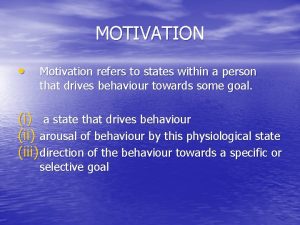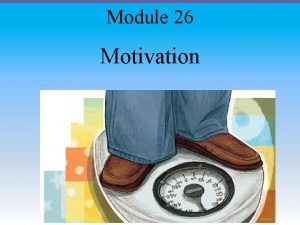Module 15 Motivation THEORIES OF MOTIVATION Motivation refers



































- Slides: 35

Module 15 Motivation

THEORIES OF MOTIVATION • Motivation – refers to the various physiological and psychological factors that cause us to act in a specific way at a particular time • Instincts • innate tendencies or biological forces that determine behavior – fixed action pattern • innate biological force that predisposes an organism to behave in a fixed way in the presence of a specific environmental condition

THEORIES OF MOTIVATION (CONT. ) • Brain: reward/pleasure center – includes several areas of the brain, such as the nucleus accumbens and the ventral tegmental area, and involves several neurotransmitters, especially dopamine – genes have been linked to several behaviors that trigger the brain’s reward/pleasure center including obesity, risk-taking, behaviors (gambling), nicotine addiction, and sexual activity

THEORIES OF MOTIVATION (CONT. )

THEORIES OF MOTIVATION (CONT. ) • Incentives – goals, that can be either objects or thoughts, that we learn to value and that we are motivated to obtain – incentives have two common features – first: can be thoughts – second: can be objects

THEORIES OF MOTIVATION (CONT. ) • Cognitive factors – Extrinsic motivation • involves engaging in certain activities or behaviors that either reduce biological needs or help us obtain incentives or external rewards – Intrinsic motivation • involves engaging in certain activities or behaviors because the behaviors themselves are personally rewarding or because engaging in these activities fulfills our beliefs or expectations

BIOLOGICAL & SOCIAL NEEDS • Biological needs – physiological requirements that are critical to our survival and physical well-being • Social needs – needs that are acquired through learning and experience • Satisfying needs – Maslow’s hierarchy of needs – ascending order, or hierarchy, in which biological needs are placed at the bottom and social needs at the top

BIOLOGICAL & SOCIAL NEEDS (CONT. )

BIOLOGICAL & SOCIAL NEEDS (CONT. ) • Maslow’s Hierarchy of Needs – Level 1 physiological needs – Level 2 safety needs – Level 3 love and belonging needs – Level 4 esteem needs – Level 5 self-actualization

HUNGER • Optimal weight – ideal weight results from an almost perfect balance between how much food an organism eats and how much it needs to meet its body’s energy needs – calorie – a measure of how much energy food contains • Overweight – means that a person is 20% over the ideal body weight – obesity – means that a person is 30% or more above the ideal body weight

HUNGER (CONT. ) • Three hunger factors – Biological hunger factors • come from physiological changes in blood chemistry and signals from digestive organs that provide feedback to the brain, which in turn, triggers us to eat or stop eating – Psychosocial hunger factors • Learned associations between food and other stimuli, such as snacking while watching television; sociocultural influences, such as pressures to be thin; and various personality problems, such as depression, dislike of body image, or low selfesteem

HUNGER (CONT. ) • Genetic hunger factors – come from inherited instructions found in our genes – determine the number of fat cells or metabolic rates of burning off the body’s fuel, which push us toward being normal, overweight, or underweight

HUNGER (CONT. ) • Biological Hunger Factors – Peripheral cues • Results from activity in different brain areas, which in turn results in increasing or decreasing appetite – Central cues • result from activity in different brain areas, which in turn result in increasing or decreasing appetite

SEXUAL BEHAVIOR • Genetic sex factors – include inherited instructions for the development of sexual organs, the secretion of sex hormones, and the wiring of the neural circuits that control sexual reflexes • Biological sex factors – include the action of sex hormones, which are involved in secondary sexual characteristics (facial hair, breasts), sexual development of ova and sperm

SEXUAL BEHAVIOR (CONT. ) • Psychological sex factors – role in developing a sexual or gender identity, gender role, and sexual orientation – psychological factors can result in difficulties in the performance or enjoyment of sexual activities

SEXUAL BEHAVIOR (CONT. )

SEXUAL BEHAVIOR (CONT. ) • Genetic influences on sexual behavior – sex chromosome – sperm or the egg – contain 23 chromosomes (contain instructions for determining the sex of the child) – egg contains the X chromosome – sperm’s chromosome can either be X (female) or Y (male) – XY means male development – XX means female development – fertilized egg is called a zygote

SEXUAL BEHAVIOR (CONT. )

SEXUAL BEHAVIOR (CONT. ) • Genetic influences on sexual behavior – differentiation – male sex organ and male brain – 5 th week after conception, the testes begin to grow and produce male hormones called androgens – most familiar is testosterone – triggers development of male sexual organ – programs the hypothalamus so at puberty it triggers the pituitary gland to secrete hormones on a continuous basis

SEXUAL BEHAVIOR (CONT. ) • Genetic influences on sexual behavior – differentiation – female sex organs and female brain – absence of testosterone in the developing embryo means automatic development of female sexual organs – hypothalamus keeps female program

SEXUAL BEHAVIOR (CONT. ) • Psychological influences on sexual behavior – Psychological sex factors • play a role in developing a sexual or gender identity, gender role, and sexual orientation – Gender identity • refers to the individual’s subjective experience and feelings of being either a male or female

SEXUAL BEHAVIOR (CONT. ) • Psychological influences on sexual behavior – Gender identity disorder • commonly referred to as transsexualism • a person who has a strong and persistent desire to be the other sex, is uncomfortable about being one’s assigned sex, and may wish to live as a member of the other sex – Gender roles • refer to the traditional or stereotypic behaviors, attitudes, and personality traits that society designates as masculine or feminine

SEXUAL BEHAVIOR (CONT. ) • Psychological influences on sexual behavior – Sexual orientation • refers to whether a person is sexually aroused primarily by members of his or her own sex, the opposite sex, or both – Homosexual orientation • pattern of sexual arousal by persons of same sexes – Bisexual orientation • pattern of sexual arousal by persons of both sexes – Heterosexual orientation • pattern of sexual arousal by persons of the opposite sex

SEXUAL BEHAVIOR (CONT. ) • Interactive model of sexual orientation – genetic and biological factors, such as genetic instructions and prenatal hormones, interact with psychological factors, such as the individual’s attitudes, personality traits, and behaviors, to influence the development of sexual orientation

SEXUAL BEHAVIOR (CONT. ) • Male-Female Sex Differences – double standard for sexual behavior • refers to a set of beliefs, values, and expectations that subtly encourage sexual activity in men but discourages the same behavior in women – biosocial theory • emphasizes social and cultural forces, says that differences in sexual activities and in values for selecting mates developed from traditional cultural divisions of labor: – women were primarily childbearers and homemakers, – men were providers and protectors

SEXUAL BEHAVIOR (CONT. ) • Male-Female Sex Differences – Evolutionary theory • emphasizes genetic and biological forces, says that our current male-female differences in sexual behavior, which we call the double standard, arise from genetic and biological forces, which in turn grew out of an ancient set of successful mating patterns that helped the species survive

SEXUAL BEHAVIOR (CONT. ) • Sexual responses, problems, and treatments – Paraphilias • sexual deviations, characterized by repetitive or preferred sexual fantasies involving nonhuman objects, such as sexual attraction to particular articles of clothing (shoes, underclothes) – Sexual dysfunction • problems of sexual arousal or orgasm that interfere with adequate functioning during sexual intercourse

SEXUAL BEHAVIOR (CONT. ) • Sexual responses, problems, and treatments – Organic factors • medical conditions or drug or medication problems that lead to sexual difficulties – Psychological factors • performance anxiety, sexual trauma, guilt, or failure to communicate

SEXUAL BEHAVIOR (CONT. ) • Sexual responses, problems, and treatments – Premature or rapid ejaculation • persistent or recurrent absence of voluntary control over ejaculation • male ejaculates with minimal sexual stimulation before, upon, or shortly after penetration and before he wishes to – Inhibited female orgasm • persistent delay or absence of orgasm after becoming aroused and excited

SEXUAL BEHAVIOR (CONT. ) • AIDS: Acquired Immune Deficiency Syndrome – HIV positive – presence of HIV antibodies, which means that the individual has been infected by the human immunodeficiency virus (HIV) – AIDS (Acquired Immune Deficiency Syndrome) life threatening condition that is present when the individual is HIV positive and has a level of T-cells or has developed one or more of 26 specified illnesses (pneumonia, skin cancer)

ACHIEVEMENT • Need for achievement – refers to the desire to set challenging goals and to persist in pursuing those goals in the face of obstacles, frustrations, and setbacks • Thematic Apperception Test – TAT, personality test in which subjects are asked to look at pictures of people in ambiguous situations and to make up stories about what the characters are thinking and feeling and what the outcome will be

ACHIEVEMENT (CONT. ) • Need for achievement – High need for achievement • shown by those who persist longer at tasks; perform better on tasks, activities, or exams; set challenging but realistic goals; compete with others to win; and are attracted to careers that require initiative – Fear of failure • shown by people who are motivated to avoid failure by choosing easy, nonchallenging tasks where failure is more unlikely to occur

ACHIEVEMENT (CONT. ) • Need for achievement – Fear of failure – Self-handicapping • refers to doing things that contribute to failure and then using these very things, knowingly or unknowingly, as excuses for failing to achieve some goal – Underachievement • underachievers are individuals who score relatively high on tests of ability or intelligence but perform more poorly than their scores would predict

ACHIEVEMENT (CONT. ) • Cognitive influences – Cognitive factors in motivation • refer to how people evaluate or perceive a situation and how these evaluations and perceptions influence their willingness to work – Intrinsic motivation • involves engaging in certain activities or behaviors without receiving any external rewards because engaging in these activities fulfills our beliefs or expectations

ACHIEVEMENT (CONT. ) • Cognitive influences – Cognitive factors in motivation – Extrinsic motivation • involves engaging in certain activities or behaviors that either reduce biological needs or help us obtain incentives and external rewards
 Module 58 trait theories
Module 58 trait theories Module 23 sleep patterns and sleep theories
Module 23 sleep patterns and sleep theories Module 23 sleep patterns and sleep theories
Module 23 sleep patterns and sleep theories Carly's therapist asks her to simply
Carly's therapist asks her to simply Module 23 sleep patterns and sleep theories
Module 23 sleep patterns and sleep theories Incentive theories of motivation
Incentive theories of motivation Sales force motivation theories
Sales force motivation theories Components of motivation
Components of motivation Theories in organisational behaviour
Theories in organisational behaviour Ib business motivation theories
Ib business motivation theories Incentive theory
Incentive theory Tujuan pengajaran
Tujuan pengajaran Chapter 7 motivation concepts
Chapter 7 motivation concepts Content theories of motivation
Content theories of motivation Motivation theories
Motivation theories C device module module 1
C device module module 1 Motivation is defined as:
Motivation is defined as: Motivation refers to forces that
Motivation refers to forces that Motivation refers to
Motivation refers to Motivation refers to
Motivation refers to Research findings on student diversity on motivation
Research findings on student diversity on motivation Teamwork training module
Teamwork training module Module 39 sexual motivation
Module 39 sexual motivation Pender health promotion model
Pender health promotion model New trade theory
New trade theory The communication cycle in health and social care
The communication cycle in health and social care Hci theories and principles
Hci theories and principles Subculture theory of aging
Subculture theory of aging Theories of corporate strategy
Theories of corporate strategy Piagetian and information processing theories 8-18 months
Piagetian and information processing theories 8-18 months Valuation of bonds
Valuation of bonds Life span theories
Life span theories Colloidal theory of gypsum
Colloidal theory of gypsum Early theories of leadership
Early theories of leadership Quiz on freud's psychoanalytic theory
Quiz on freud's psychoanalytic theory Theories of justice
Theories of justice

